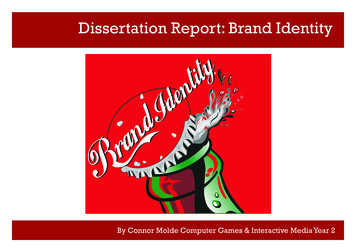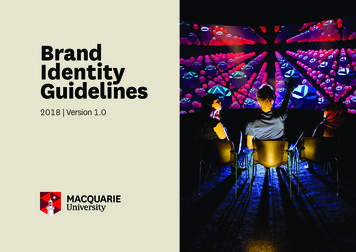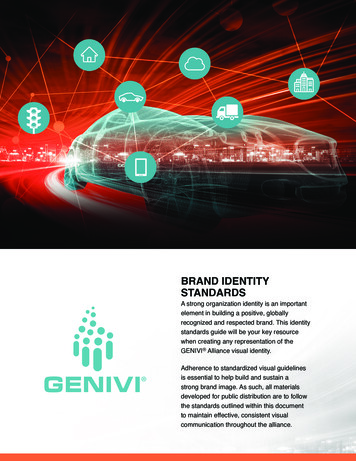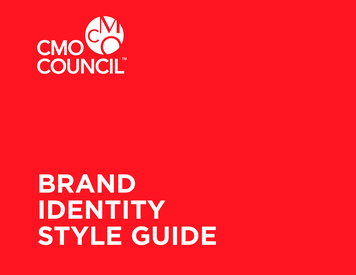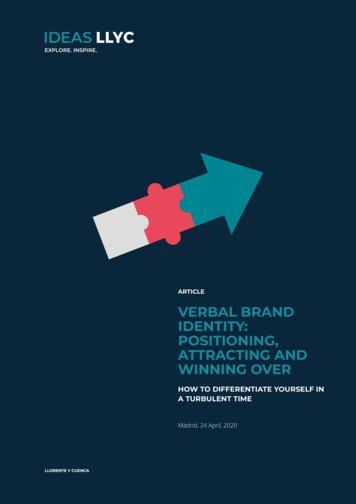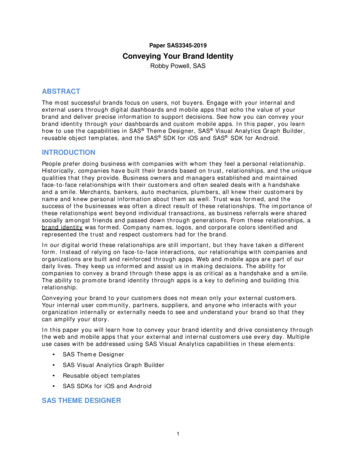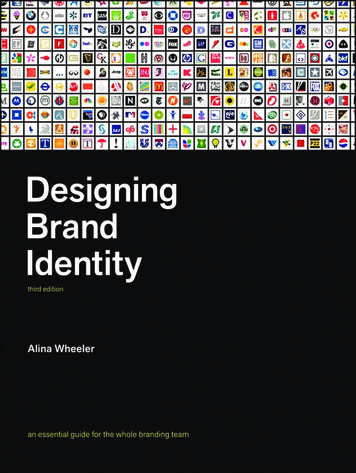
Transcription
Brand identity ferentiationFlexibilityA compelling vision by an effective,articulate, and passionate leader is thefoundation and the inspiration for thebest brands.Brands always compete with each otherwithin their business category, and atsome level, compete with all brands thatwant our attention, our loyalty, and ourmoney.An effective brand identity positions acompany for change and growth in thefuture. It supports an evolving marketingstrategy.MeaningThe best brands stand for something– abig idea, a strategic position, a defined setof values, a voice that stands apart.CommitmentDurabilityDurability is the ability to have longevityin a world in constant flux, characterizedby future permutations that no onecan predict.ValueAuthenticityAuthenticity is not possible without anorganization having clarity about itsmarket, positioning, value proposition,and competitive difference.Organizations need to actively managetheir assets, including the brand name,the trademarks, the integrated sales andmarketing systems, and the standards.CoherenceWhenever a customer experiences abrand, it must feel familiar and have thedesired effect. Consistency does not needto be rigid or limiting in order to feel likeone company.Building awareness, increasingrecognition, communicating uniquenessand quality, and expressing a competitivedifference create measurable results.31
Brand identity idealsVisionVision requires courage. Big ideas, enterprises, products, and services are sustainedby individuals who have the ability to imagine what others cannot see and the tenacityto deliver what they believe is possible. Behind every successful brand is a passionateindividual who inspires others to see the future in a new way.Brand identity begins with a conversation aboutthe future. Hearing the vision face to face iscritical to the brand identity process. Leaderswho take the time to share their most audaciousdreams and challenges frequently understandthe power of symbols and storytelling to buildtheir culture and brands.Strategic designers have the uncanny ability tolisten deeply and synthesize vast amounts ofbusiness-critical information with an overarchingvision. The role of design is to anticipate thefuture before it happens. Brand identity systemsoften prototype the possibilities and sparkmeaningful dialogue.Design advocates the future.Bill StumpfDesignerOur business practice isfocused on offering peopleavenues to express theiridealism, passion, andcommitment to causes largerthan themselves at every pointalong our supply chain—fromsuppliers and partners toshareholders, customers, andour own staff.Jeffrey HollenderChief Inspired ProtagonistSeventh GenerationGreat leaders see the future,set a course, and pursue itrelentlessly. They conquerthe present despite criticism,ambiguity, adversity. Theyreflect on, learn from, andweave patterns from the past.Great leaders possess thehumility, optimism, passion, andwisdom to inspire others andevoke their full commitment.Dr. Karol WasylyshynPresidentLeadership Development ForumThe desire to connect withothers is the most basichuman desire. Living a bitmore publicly, and withmore transparency, can havepowerful, positive effects. Youmeet people, you’re providedwith new opportunities, youhave the ability to expressyourself, and to have anauthentic open way to liveyour life.Evan WilliamsCo-founder, TwitterFounder, BloggerThe client is the author. We are the interpreter. Bart Crosby, Crosby Associates32A business is rightly judgedby its products and services,but it must also face scrutinyas to its humanity.D. J. DePreeFounderHerman Miller
Being a sustainable business isintrinsic to Herman Miller’s spirit,values-based leadership, andheritage, as is its leadership indesign innovation. The companythat designed the Aeron chair isalso the company that helped formthe US Green Building Council.Herman Miller believes in design asa way to solve significant problems.Over its history, collaborations withdesigners like George Nelson,Charles and Ray Eames,Bob Probst, Bill Stumpf, Studio 7.5,Ayse Birsel, and Yves Béhar havechanged the course of residentialfurniture and the interior landscapeof workplaces worldwide. Ascreative director, Steve Frykholm,ensures that design innovationextends to all brand touchpointsacross media.33
Brand identity idealsMeaningThe best brands stand for something: a big idea, a strategic position, a defined set ofvalues, a voice that stands apart. Symbols are vessels for meaning. They become morepowerful with frequent use and when people understand what they stand for. Theyare the fastest form of communication known to man. Meaning is rarely immediateand evolves over time.Symbols engage intelligence, imagination, emotion,in a way that no other learning does.Georgetown University Identity Standards ManualNike was named after the Greekgoddess of victory. Nike’s logo, anabstraction of a wing, designedby Carolyn Davidson in 1971, wasmeaningful to a company thatmarketed running shoes. In 1988,Nike’s “Just do it” campaign becamea battle cry for an entire generationof athletes. When consumers seethe “swoosh,” as it is called, they areinspired by the bigger idea to livethe slogan.34Apple customers quickly becomebrand zealots. When they see theApple logo, they think innovationand delight. The logo, designed byRob Janoff in 1976, is an apple witha bite out of it–a friendly symbolof knowledge, and as lore has it, asymbol of anarchy from the PC world.The original logo was filled withrainbow stripes, but now it is a simpleone-color icon.When the Mercedes-Benz logowas originally created by GottliebDaimler in 1909, it consisted of asimple depiction of a three-pointedstar that represented the company’s“domination of the land, the sea,and the air.” Now this brandmarkstands first and foremost for luxuryand for the fastest cars on the road.The symbol has been dramaticallysimplified over the last century andremains highly recognizable.This symbol was designed forBarack Obama’s U.S. presidentialcampaign in 2006. The O, createdby Sol Sender and his firm, SenderLLC, symbolized the dawn of a newday. Obama’s messages of hopeand change charged the symbolwith a deeper level of meaning thatresonated with citizens the worldover, and became part of the largestsocial media campaign in history.
The logo is the gatewayto the brand.Milton GlaserDesignerMeaning drives creativityMeaning evolves over timeDesigners distill meaning into unique visual formand expression. It is critical that this meaningis explained so that it can be understood,communicated, and approved. All elements ofthe brand identity system should have frameworkof meaning and logic.As companies grow, their businesses may changesignificantly. Similarly, the meaning assigned to abrandmark will probably evolve from its originalintention. The logo is the most visible and frequentreminder of what the brand stands for.Meaning builds consensusMeaning is like a campfire. It’s a rallying pointused to build consensus with a group of decisionmakers. Agreement on brand essence andattributes builds critical synergy and precedesany presentation of visual solutions, namingconventions, or key messages.Think flag.A nation’s flag begins as adesign. Distinctive colorsand shapes are chosen fortheir symbolic meaning.The flag is unique anddramatically different fromother nations. Seeing theflag arouses feelings ofpride, passion, or disdain.Logos are the same.Mitsubishi stands for quality andreliability and embodies a 130-yearold commitment to earning thetrust and confidence of peopleworldwide. Protecting the trademark,designed by Yataro Iwasaki, is a topcorporate priority. Each diamondrepresents a core principle: corporateresponsibility to society, integrityand fairness, and internationalunderstanding through trade.The CBS eye has been the televisionnetwork’s symbol for over a halfcentury. It has remained unchanged,and has retained its original powerful,all-seeing iconic quality. Originallyinspired by the human eye paintingson the side of Shaker barns to wardoff evil, it is a highly recognizedsymbol around the world. Designedby William Golden, it was one of thefirst symbols designed to functionprimarily on the screen.The Leadership in Energy andEnvironmental Design (LEED) GreenBuilding Rating System encouragesand accelerates global adoption ofsustainable green building throughthe implementation of universallyunderstood and accepted toolsand performance criteria. Thisemblem on a building engenderstrust. It communicates that thebuilding project is environmentallyresponsible, profitable, and a healthyplace to live and work.35
Brand identity idealsAuthenticityIn psychology, authenticity refers to self-knowledge and making decisions that arecongruent with that self-knowledge. Organizations who know who they are, and whatthey stand for, start the identity process from a position of strength. They createbrands that are sustainable and genuine. Brand expression must be appropriate to theorganization’s unique mission, history, culture, values, and personality.As reality is qualified,altered, and commercialized,consumers respond towhat is engaging, personal,memorable and aboveall, what they perceiveas authentic.Know thyself.Joe PinePlatoCo-authorAuthenticityFirst AlcibiadeslogoAuthenticity, for me, isdoing what you promise,not “being who you are.”look and feeltargeted messagescore messageswe know who we are36Seth Godin
Each day, 1.2 billion people aroundthe world have a Coca-Colaproduct. Turner Duckworthrevitalized the iconic brandpresence and created a visualcelebration of the simple pleasureof having a Coke across everythingfrom cups to trucks. Researchrevealed that there was a culturallonging for Coke to be greatagain. The branding process gaveCoke the confidence to drivesimplicity, and communicate moreemotion and meaning throughiconography, wit, and bold design.Coca-Cola: Turner Duckworth37
Brand identity idealsDifferentiationBumper-to-bumper brands clamor for our attention. The world is a noisy place filledwith a panoply of choice. Why should consumers choose one brand over others? It is notenough to be different. Brands need to demonstrate their difference and make it easy forcustomers to understand that difference.If your brand suddenly didn’texist, would anyone miss it?A really good brand leaves abig gap.Juan Pablo RamírezBrand StrategistSaffron Brand ConsultantsWhen everybody zigs, zag.Marty NeumeierZAGIn order to be irreplaceable onemust always be different.Coco Chanel Ed Wheeler PhotographyHouse of Chanel38
39Courtesy of allmyfaves.com
Brand identity idealsDurabilityBrands are messengers of trust. We are all moving at blinding speed and our institutions,technology, science, lifestyles, and vocabulary are in a state of continuous flux.Consumers are reassured by trademarks that are recognizable and familiar. Durability isachieved through a commitment to the equity of a central idea over time, and the capacityto transcend change.Trademarks, by definition, must last well beyondthe fashion of the moment.Chermayeff GeismarThree years after the carwas born (1896), Bibendum, thename of the Michelin Man, becamethe company’s unique symbol.Redrawn numerous times, the “tireman” is immediately recognizablearound the world.40
Trademarks and their date of inness1862London Underground1933Metropolitan ubishi1870IKEA1943Eastman Kodak1971Nestlé1875CBS1951Nike1971Bass Ale1875NBC1956Quaker Oats1972John Deere1876Chase Manhattan1960Atari1973Johnson & Johnson1886International Paper1960Merrill Lynch1973Coca-Cola1887Motorola1960United Way1974General Electric1892Westinghouse1960Dunkin’ Donuts1974Prudential1896UPS1961I Love l1900McDonald’s1962PBS1976Nabisco1900General Foods1962United1976Ford1903Wool Bureau1964Apple1977Rolls-Royce1905Rohm & AT&T1984IBM1924Diners Club1966Google1998Since John Deere’s founding, the leaping deer has been the core identity element.1878191219361937195019561968200041
Brand identity idealsCoherenceWhether a customer is using a product, talking to a service representative, or makinga purchase on their iPhone, the brand should feel familiar and the experience shouldhave the desired effect. Coherence is the quality that ensures that all the pieceshold together in a way that feels seamless to the customer. It doesn’t need to be rigidand limiting—rather, it is a baseline that is designed to build trust, foster loyalty,and delight the customer.The goal in creating abrand identity is not justsurface consistencybut inner coherence.Aubrey BalkindHow is coherence achieved?Unified voice, a dynamic central ideaLook and feelThe company is clear about its positioning and howit wants to be perceived. Every communicationuses a consistent voice and evolves from a centraldynamic idea.A brand identity system is unified visually andstructurally. It builds on cohesive brand architectureand utilizes specially designed colors, typefacefamilies, and formats. The identity system advancesimmediate recognition of the company andsupports brand attributes across various media.One company strategyAs companies diversify into new areas of business,consistency jumpstarts awareness and acceptanceof new initiatives.Every touchpointCoherence emerges from understanding theneeds and preferences of the target customerand designing a brand experience that produces adesired perception. Every touchpoint is considereda brand experience.42Uniform qualityA high and uniform level of quality imparts a degreeof care that is given to each of the company’sproducts and services. Anything less than superiorquality reduces the value of the asset on both aconscious and unconscious level.Clarity and simplicityUsi
Brand identity ideals Three years after the car was born (1896), Bibendum, the name of the Michelin Man, became the company’s unique symbol. Redrawn numerous times, the “tire man” is immediately recognizable around the world. Trademarks, by definition, must last well beyond the fashion of the moment. Chermayeff Geismar Brands are messengers of trust. We are all moving at blinding

